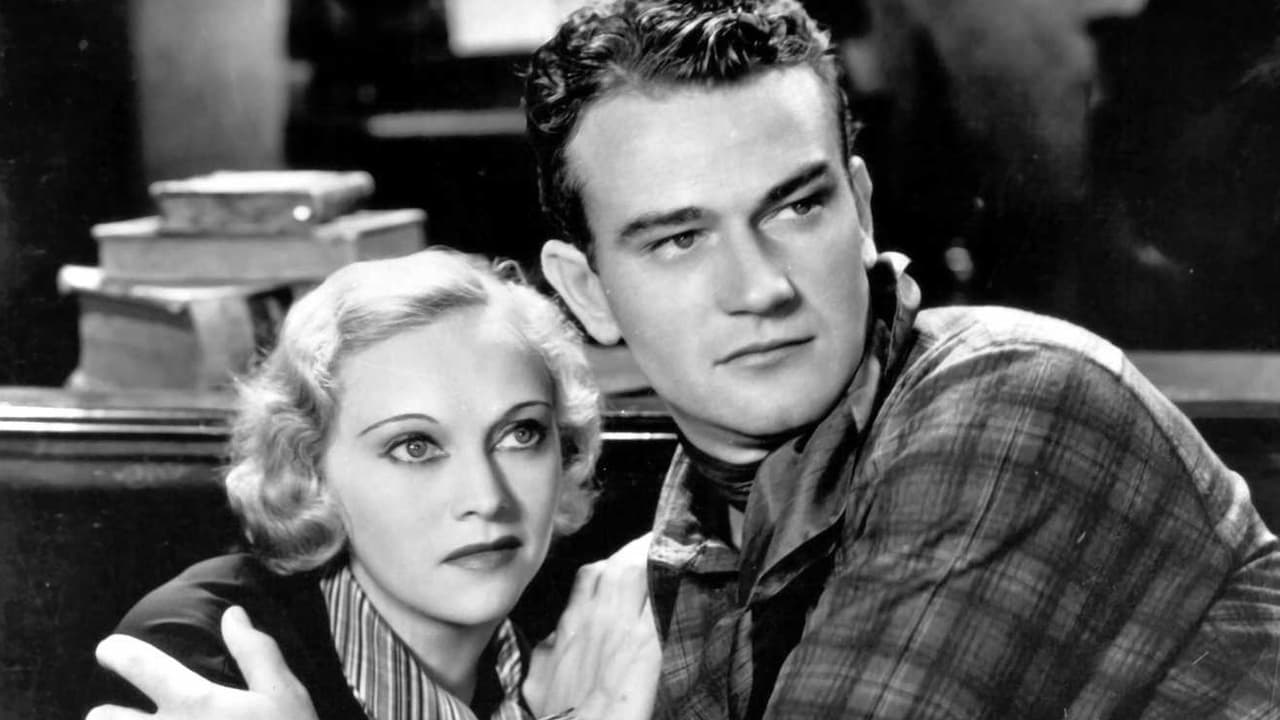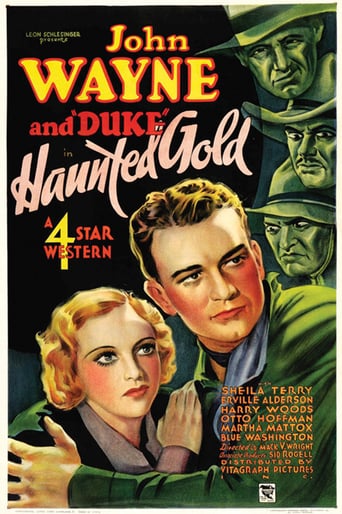

On a dark and windy night, harmonica-playing cowboy John Wayne (as John Mason) arrives in a shadowy town, atop his smart-witted horse "Duke". Mr. Wayne is annoyed to find slavish, dim-witted cook Blue Washington (as Clarence Washington Brown) has followed; the servant was ordered to remain back at the ranch. A noticeably superstitious man, Mr. Washington wants to help boss Wayne, but crooks don't fear his "watermelon accent." Wayne's mission is to claim his half-share in a gold mine. He meets pretty blonde Sheila Terry (as Janet Carter), who also may be entitled to a half-interest in the mine... Wayne must battle dastardly Harry Woods (as Joe Ryan) before he and Ms. Terry can put their halves together. "Haunted Cave" has a couple of good action sequences, but they must have been lifted from "The Phantom City" (1928), with actor Ken Maynard and/or his stunt-man in Wayne's role. Washington reprised his role from the earlier film, where his "watermelon accent" was depicted on title cards. As the housekeeper, Martha Mattox is a welcome fright.** Haunted Gold (12/17/32) Mack V. Wright ~ John Wayne, Blue Washington, Sheila Terry, Harry Woods
... View MoreHaunted Gold (1932) ** 1/2 (out of 4) This was one of six films John Wayne made for Warner's years before he would become famous after the success of STAGECOACH. Wayne has to share top billing with Duke, his horse, but I'm sure he didn't mind that too much. Rival gangs both want the claim to a mine, which might be full of gold but the big problem is that it's haunted with the spirit known as The Phantom. This early blend of the Western and "old dark house" genre isn't as bad as you'd expect, although there's some rather strange and mean spirited racism throughout the movie. One interesting thing was that Blue Washington, a black actor, got to play the sidekick to Wayne, which was a nice change of pace considering most sidekicks at that time were white. This new item quickly turned sour as for the most part he was just playing the ignorant stereotype, which included various jokes being thrown at him including being called "Darkie" and one scene where he pretends to be The Phantom only to have a guy say he wasn't because of his "watermelon accent". Outside of that, this is a fairly enjoyable film that manages to make good use of both genres. The horror elements start off with an animated sequence with some bats and the shadow of what's clearly meant to be a Dracula like character. We get the various "spooky" items including cobwebs, black cats, rats and other goodies. The red herrings pop up from time to time and are way too obvious. Check out the scene where Wayne is having coffee with his girl (Sheila Terry) only to have the maid acting like a bad guy. How obvious and over the top she is made me break down laughing. Wayne gives a decent performance even though he hadn't quite gotten his style down yet but I don't think there's any doubt that Duke gets the best scenes.
... View MoreHaunted Gold is not a bad western for John Wayne from the series he made at Warner Brothers in 1932-1933. He's the owner of a ranch who's investigating some strange goings on at a mine where his father was once the part owner. The daughter of his dad's partner, Sheila Terry, received a letter about the mine and she's on the scene as well.There's a mysterious 'phantom' at work and Haunted Gold is starting to bare a resemblance to Abbott and Costello's Hold That Ghost. Never mind that it's a remake of an old Ken Maynard silent western.The comedy here comes from Blue Washington who plays Clarence Washington Brown, cook at Wayne's ranch and self-appointed bodyguard to his person. Sad to say that Blue Washington conforms generally to prevalent black stereotypes of the period. But actually if you take away the racial component, Washington really does act a whole lot like Lou Costello.As in all of Wayne's Warner Brothers films of the time, the Duke is aided and abetted by Duke the Wonder Horse. Most exciting scene is a fight with John Wayne and one of Harry Woods's gang of bad guys in a cable car above the mine. Duke the Horse comes to Wayne's rescue twice during that scene, actually quite exciting.It's too bad the racial stereotyping was there, but wouldn't a film with John Wayne with Lou Costello as a sidekick been real interesting? The mind boggles.
... View More"Haunted Gold" was one of six "B" westerns produced by Warner Bros. for the 1932-33 season starring John Wayne. They were either out and out remakes of silent Ken Maynard films or they borrowed liberally, stock footage of Maynard and his horse Tarzan.The plot involves an abandoned gold mine haunted by a mysterious stranger known only as "The Phantom". Cowboy John Mason (Wayne) and his sidekick Clarence (Blue Washington) ride in to the mine site. Joe Ryan (Harry Woods) and his gang have already arrived looking for a lost gold treasure. Mason and Ryan are half owners of the mine, Mason having inherited his share from his father and Ryan having cheated the rightful owner out of his share.Lurking about are the mine's former manager Tom Benedict (Erville Anderson) and his servant Simon (Otto Hoffman). Janet Carter (Sheila Terry) the daughter of the rightful owner of her half interest is also on hand. It seems that all have been summoned to the site by mysterious notes to each from "The Phantom". Meanwhile, "The Phantom" skulks about peering out from behind secret panels keeping an eye on the proceedings.Mason and Janet team up to foil Ryan's attempts to gain control of the gold. Finally, "The Phantom's" identity is revealed and.................This film is arguably the best of Wayne's six Warner Bros. westerns. There were better production values than he would have in his later Lone Star westerns and he had the advantage of working for a major studio. The animated owls over the opening titles are the work of Producer Leon Schlesinger who was better known as the head of Warners Looney Tunes/Merrie Melodies cartoon factory.Wayne and his horse "Duke" were made up to match stock shots of Maynard and "Tarzan" in the earlier silent films. Long shots of the hero and horse and most of the stunts and stunt riding is Maynard.Having been filmed in 1932, two years before the implementation of Hollywood's Production Code, this film contains several racial slurs involving the "Clarence" character who is black. He is called both a "Darkie" and "Sambo", by the Woods character and is referred to as the hombre with "the watermelon accent" by gang members. Wayne's character even calls him "boy" in one scene.For trivia buffs, look for the statue that was used as the falcon in "The Maltese Falcon" (1941) atop the heroine's organ as she plays.
... View More